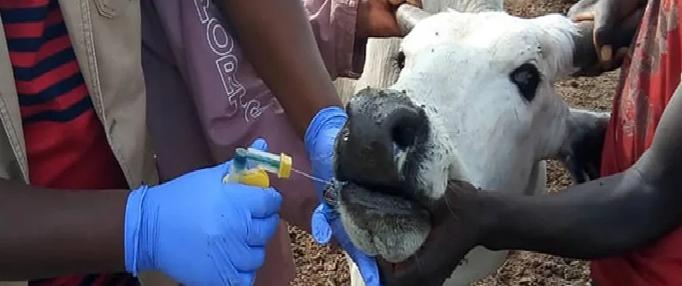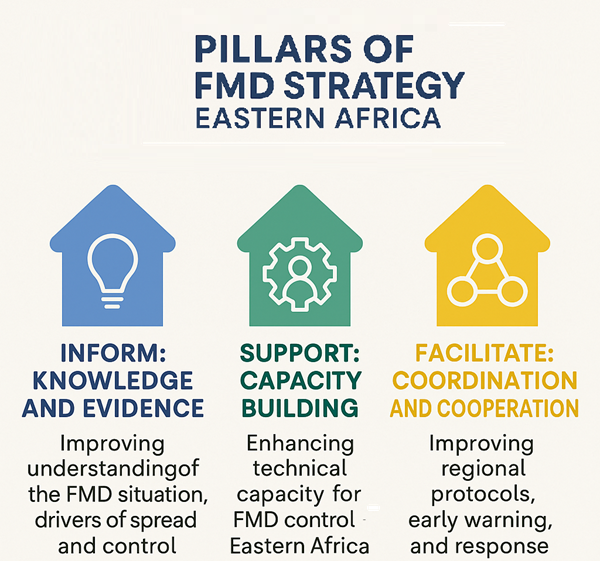
Eastern Africa Confronts Endemic Foot and Mouth Disease Threat as Regional Stakeholders Validate Long-Term Control Strategy

Foot-and-mouth disease (FMD) remains one of the most persistent threats to livestock production, food security, and trade across Eastern Africa. Despite being routinely ranked among the top three priority diseases by governments and livestock keepers, the region continues to experience widespread outbreaks, significant economic losses, and constrained market access due to insufficiently coordinated control measures. The extensive mobility of pastoral herds, porous borders, and limited surveillance and laboratory capacity further complicate containment efforts. Without a harmonised regional approach, national initiatives alone cannot effectively manage the transboundary nature of FMD or mitigate its cascading impacts on livelihoods, nutrition, and national economies.
It is against this backdrop that regional and international stakeholders gathered yesterday in Nairobi for the Consultation and Validation Workshop of the Strategic Framework for the Control of Foot-and-Mouth Disease (FMD) in Eastern Africa 2026–2035. The two-day meeting, held at the Trademark Hotel, Nairobi, brought together representatives from AU-IBAR, IGAD, EAC, FAO, WOAH, UNEP, GALVmed, national Chief Veterinary Officers, FMD focal points, wildlife authorities and technical experts from across the Eastern Africa FMD Roadmap countries.
A Timely Response to an Urgent Regional Challenge
In her opening remarks, Dr. Huyam Salih, Director of AU-IBAR, underscored the scale of the challenge. Livestock underpin food and nutrition security and sustain hundreds of millions of people, yet transboundary animal diseases such as FMD drain billions of dollars from Sub-Saharan Africa each year. Dr. Salih stressed that no single country can manage FMD independently and called for deeper regional coordination, harmonisation, and joint action to address surveillance gaps, strengthen early detection, and ensure rapid response.
She emphasized that the new Strategic Framework provides a necessary mechanism to align national priorities with regional objectives, operationalize shared protocols, and leverage collective capacities. The Framework also responds directly to commitments articulated under Agenda 2063, CAADP (2026–2035), LiDeSA, and the Animal Health Strategy for Africa.
A Strategy Built on Regional Realities and National Inputs

The Strategic Framework for 2026–2035 was developed through extensive consultation, including inputs from the Eastern Africa FMD Roadmap Meeting held in Dar es Salaam in 2024. Delegates highlighted weaknesses such as inadequate vaccination coverage, limited laboratory capabilities for serotyping and vaccine matching, fragmented movement control, and insufficient political commitment and financing for sustained FMD control. These challenges, combined with the region’s ecological and socio-economic dynamics, informed the structure of the Framework.
The strategy is anchored on three mutually reinforcing pillars:
- Knowledge and Evidence – establishing regional information-sharing platforms, conducting research, and improving tools for risk assessment, economic analysis, and epidemiological understanding.
- Capacity Building – providing regionally tailored trainings and sourcing essential equipment for surveillance, vaccination, diagnostics, programme management, and public–private partnership models.
- Coordination and Cooperation – harmonising regional protocols, strengthening early warning systems, enhancing rapid response, and facilitating affordable vaccine access through bulk procurement and strengthened laboratory networks.
Collectively, these pillars aim to support countries in progressing along the Progressive Control Pathway for FMD (PCP-FMD) and achieving more secure, efficient livestock systems with improved trade performance.
Deliberations and Validation
Throughout the workshop, participants engaged in structured group work to analyse the draft document, identify gaps, and propose improvements. Presentations on Day 2 allowed country groups to showcase recommendations, including strengthening regional strain monitoring, developing cross-border agreements for sample shipment, institutionalising biosecurity practices in markets and abattoirs, and reinforcing communication strategies to maintain political will.
Plenary discussions refined these inputs and integrated them into the final version of the Framework. The review process reaffirmed the need for pragmatic, risk-based interventions that consider the diverse production systems and varied PCP stages across the 12 roadmap countries.
Looking Ahead
In closing, Dr. Salih reaffirmed AU-IBAR’s commitment to supporting Member States and Regional Economic Communities in translating the Framework into concrete action. She noted that the forthcoming rollout of ARIS3 will enhance disease reporting and situational awareness—an essential component of early warning and regional coordination.
With the validation of the Strategic Framework, Eastern Africa has taken a decisive step toward a more structured, collaborative, and evidence-driven approach to FMD control. The region now moves toward developing the implementation plan, mobilising resources, and establishing governance mechanisms to guide the strategy between 2026 and 2035.
By confronting FMD through unified regional action, Eastern Africa strengthens its prospects for improved livestock productivity, enhanced food and nutrition security, resilient livelihoods, and expanded opportunities in domestic and export trade.
